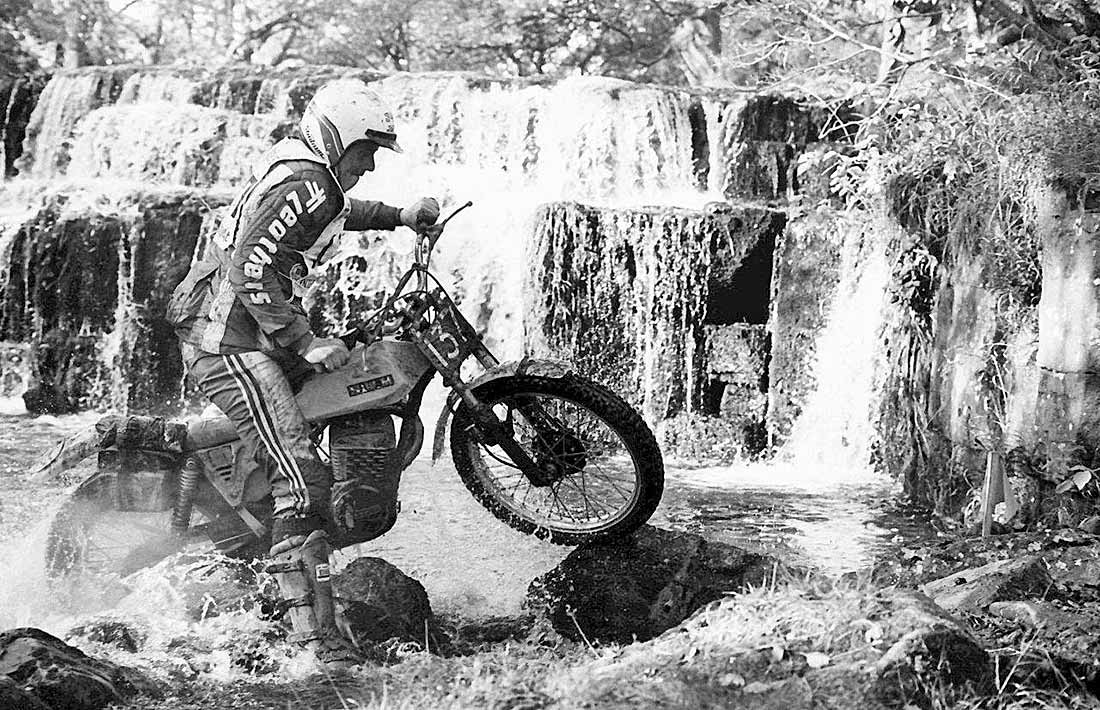ON TEST: Vertigo Combat Camo/ Ice Hell
By John Dickinson on 13th Apr 16

VERTIGO is a very recent, very enthusiastic and very ambitious off-road manufacturer.
It is the brainchild of successful Barcelona businessman Manel Jane, a full-on trials enthusiast who has long held a dream of building his own trials machine.
But Vertigo is no mere flight of fancy. Manel is a shrewd operator with all the right contacts and has not rushed into this venture at what is clearly a difficult time for the trials industry.
His approach has been carefully researched and there is both a far-reaching plan and a budget to match.
Vertigo has started with a clean sheet of paper and the first machines to be designed and built have been with the future, not the past, very much in mind.
Trials has always lagged behind the rest of motorcycling when it comes to technology with road racing, road bikes, then motocross benefitting, with trials eventually picking up the crumbs.
Not any more, Vertigo has now set a standard of technology that others will have to chase, especially in the engine department where the electronics take trials tuning and efficiency to new levels.
Efi and ignition, controlled by an ECU IS the future, whether you like it or not, so the Vertigo Combat has been designed specifically with this in mind, not an existing model that has been adapted.
What we have here is our first test on British soil of the Combat Camo and Ice Hell models.
The Combat is effectively the standard version of the Combat range, the Ice Hell is an up-specced ‘Factory' version – and there is still a very special limited edition Titanium model to follow later in the year.
The Combat sports a space-type tubular steel chassis – as used by Ducati and KTM on road and race bikes but a first for a production trials model – that utilises a rigid aluminium rear sub-assembly.
The chassis is completed by Tech forks up front and a Reiger shock at the rear, controlling a neat-looking aluminium swinging arm via a linkage system.
The all-new electronically fuel-injected (efi) two-stroke engine sits comfortably in this chassis and the fuel tank nestles behind, wrapped round the rear shock.
This keeps the centre of gravity and centre of mass impressively low down – and the balance of the chassis does not alter as the fuel level drops.
The six-speed gearbox mirrors Honda engineering practise and is super positive in gear selection.
One change from standard practise is the adoption of a remote, electrically-operated coolant pump.
This only draws power from the engine when needed and is also out of harm's way mounted behind the cylinder keeping the crankcases impressively narrow.
Aiding engine cooling is a unique v-shaped radiator for maximum heat dissipation.
The air-filter now sits high over the engine, right out of the water and mud and is accessed under its plastic cover by removal of a single screw for easy maintenance.
The clever bit is obviously the ECU and associated sensors which allow total control of both ignition and fuel injection for ultra-fine tuning.
The rider has the option of four different maps to choose from in each of the six gears. Don't panic, there is a base standard setting and then variations to suit different conditions or riding style.
A simple press of a button is all it takes to switch maps.
Apart from the obvious applied technologies, the Vertigo follows standard practise. Suspension, wheels, brakes, bars, levers etc are all the tried and tested standard fare that we are all familiar with.
As well as the standard Camo model we also got to try the very first Ice Hell version to hit GB. This is effectively the "factory” replica.
Distinguished by its sparkling white paintwork, Ice Hell sports magnesium engine cases, a titanium exhaust front pipe – standard is thinwall stainless steel, a good titanium lookalike – lightweight machined hubs with individual spoke and even a waisted steering head tube which saves precious grammes (ounces, in old money).
Both models tested were 300cc as these are all that's available at the moment but 250s will follow very shortly – and we will be straight out on one when they arrive...
TMX tester Woody Hole has ridden just about everything there is to ride so he did the honours on the Vertigo.
Here's what he had to say:
"The first thing I noticed is that the bike looks much better in real life than in pictures.
Because of its electronics there seems to be a lot going on in the engine department, compared to a normally carbureted two-stroke but it is all necessary and neatly organised.
I remember the first prototypes which were really messy but they did their job and now the bikes look really smart with lots of nice touches and neat brackets.
To start you have to press a button which turns on a battery to excite the ECU. The battery is self-charging from the generator. If you stop the engine for 20 seconds it switches off so effectively you press the button for each start. This soon becomes second nature.
The bike starts really easily for a 300 and instantly ticks-over and runs cleanly and smoothly.
There is no ‘loading-up' with fuel and you can leave the motor ticking over at any angle and there is no petrol spilling out of float bowls and the engine runs ultra clean.
With four maps to choose between there is a mode for everybody and believe me they make a massive difference.
This is because the electronics control fuel and ignition so can make significant change.
The standard setting is ONE. Press the map button and a light blinks twice, this is mode TWO, repeat for modes three and four.
Now, mode two richens the mixture and is softer power and mode three is softer again.
Then, four leans things off considerably and you have a seriously quick-action motor. I can see the top lads using this for big climbs or maybe steps when they really want some poke.
In reality the standard setting is best for most riders most of the time. That is why it is the standard setting!
The power is really soft, controllable and torquey and unlike most 300s does not pull your arms out yet it picks up its tail and goes when you open the throttle.
The gearbox is a six-speed unit, with the usual bottom four all usable in sections with fifth for tracks and moors and sixth for road cruising.
What I noticed most was the short throw of the gear lever and how positive gear selection was.
Really positive and no need to worry if the gear is engaged.
Running gear... as we said there's lots of ‘normal' tried and tested stuff that is seen on most trials bikes but the Vertigo also has loads of stuff, mainly electrical, unique to this brand because of the technical nature of the project.
On the suspension front there's the usual suspects up front, ally Techs, which worked great and the rear was a Reiger which felt good and was getting better and better as the ride went on as they were brand new bikes!
All new bikes handle similarly and all will jump up rock steps.
When riding, everything felt solid and worked a treat, the riding position was spot on and it felt lovely and stable between the legs, there is something to grip without it being too wide and the bike feels really planted.
Maybe not as lively as some but absolutely rock steady in the section.”
VERTIGO is of course a Spanish project but there has been plenty of British input through Dougie Lampkin and James Dabill.
Doug has been heavily involved with the development work and let's not forget that the 12 times World Champion has plenty of experience on this front.
Doug has experience in developing Beta and Montesa two-strokes before being instrumental in the all-new and ground breaking Montesa 4RT.
When you think about it the four-stroke 4RT is little different now to when Doug left Montesa. He then went on to help Gas Gas develop their two-stroke to give Adam Raga the best possible chance of challenging Toni Bou before Manel Jane snapped him up to take the Vertigo forward.
And of course Doug proved that he knows exactly what he's doing by taking that storming ninth Scottish Six Days win on Vertigo's debut in the classic event.
As Vertigo team manager he then steered James Dabill to the British Championship giving the factory their first National title.
And of course Doug is the British importer of the brand.
Conclusion: This is a very different trials machine in both looks and technology.
I was pleasantly surprised at the quality of components and overall finish and also the performance as it was absolute top quality.
Trials riders in general are a pretty conservative bunch, they like what they know and don't like change.
But Vertigo is forcing that change and what they are giving you in trials terms is tomorrow – but you get it today.


